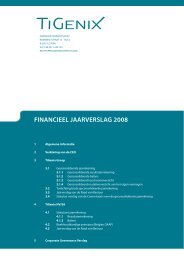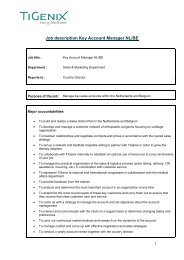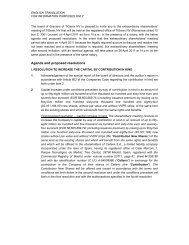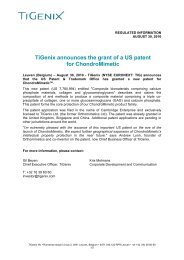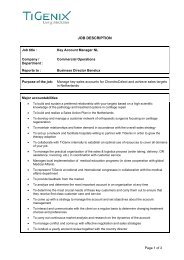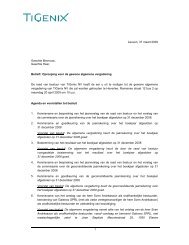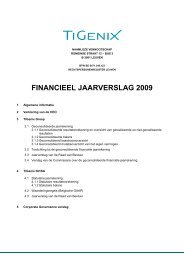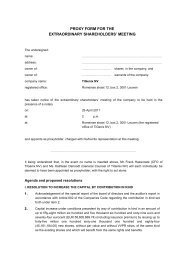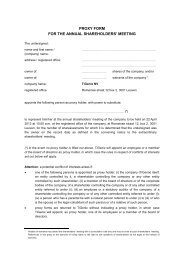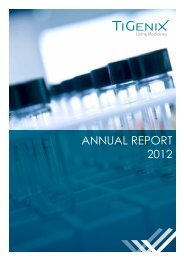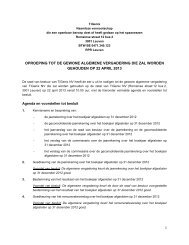ANNUAL FINANCIAL REPORT 2010 2010 - TiGenix
ANNUAL FINANCIAL REPORT 2010 2010 - TiGenix
ANNUAL FINANCIAL REPORT 2010 2010 - TiGenix
- No tags were found...
Create successful ePaper yourself
Turn your PDF publications into a flip-book with our unique Google optimized e-Paper software.
In developing Cx601, Cellerix has been able to build uponcertain preclinical and CMC data obtained for the developmentof Cx401 as well as capitalize on the regulatory experience(the Phase III trial in Crohn’s patients was approved in eightEuropean countries).Cx601 recently completed a multicentre (6 centres) phase IIclinical evaluation on 24 patients.The final clinical report was received in December <strong>2010</strong> andconfirmed the safety of allogeneic eASCs (including noimmune-reaction to allogeneic eASCs determined after first orsecond administration) and the efficacy of the compound inthe treatment of complex perianal fistula.Efficacy at twenty four weeks after implant was >56% in thetreated fistula tracts. Efficacy was measured as the completeclosure and re-epithelisation of the fistula being treated withabsence of drainage. Additionally, 69.2% of patients had areduction in the number of initially draining tracts.Based on these results, Cellerix sought scientific advice fromEMA in March 2011 on the future development path of Cx601.The scientific advice meeting was held on March 3, 2011 andpositive feedback was received on a proposed trial design for afollow-on trial of the compound.Cx611ProductCx611 is an allogeneic cellular suspension of living adult stemcells of mesenchymal origin (eASCs), extracted from adiposetissue. The first intended application for which Cx611 isbeing developed is the treatment of rheumatoid arthritis viaintravenous (i.v.) infusion.IndicationRheumatoid Arthritis (“RA”) constitutes an inflammatory,autoimmune, systemic and chronic disease which incidencehas been maintained through decades and represents the mostcommon inflammatory arthritis, affecting 0.3% to 1% of thegeneral population in industrialized countries. 70RA has a great impact on the patient’s quality of life and givesrise to important economic and social costs. It is remarkablethat within ten years of the start of the disease condition, halfof those with rheumatoid arthritis are unable to hold down afull-time job. The economic burden associated to the treatment70 WHO Report “The global burden of rheumatoid arthritis in the year 2000”.Deborah Symmons Colin Mathers, Bruce Pfleger.of RA is huge for any health care economy and is estimated thatthe combined annual economic cost of this disease is up to45.5 billion Euros across Europe (Lundkvis et al 2008).The current pharmacological management of rheumatoidarthritis involves early intervention with synthetic diseasemodifying anti-rheumatic drugs (“DMARDs”) either singlyor in combination. If inflammation cannot be adequatelysuppressed by these means, biologic DMARDs targeting thepro-inflammatory cytokine TNF are employed. In the event ofinadequate response, dose optimisation (i.e. in the case of theanti-TNFα Infliximab), further anti-TNFs, or alternatively, biologicsof a different mechanism of action class can be used. Despite allthese treatments, RA remains as an insufficiently unmet clinicalneed where several concerns about long term treatmentsbased on biologics are documented (Bongartz, 2009):• Lack of efficacy of biological treatments in some patients,non-tolerability or recurrent secondary infections have beenfactors which have contributed to the need of developingnew therapies.• Adverse effects from current antirheumatic medicationoccur, affecting various organ systems and sometimes beingserious.• It is estimated that approximately 20-40% of RA patients donot have an adequate response to treatment with anti-TNFagents.Clinical developmentIn January 2011, Cellerix obtained official approval by theSpanish Medicines Agency to start a Phase I/II clinical trial usingallogeneic eASCs, for the intravenous treatment of rheumatoidarthritis.The protocol for this study has been drafted in closecollaboration with an advisory board comprised ofinternationally recognized experts in novel and early outcomestudies in RA.Local scientific advice with the Spanish Medicines Agencyregarding preclinical package of the clinical trial submission andthe Phase I/II trial design was finalized in September <strong>2010</strong>.The primary objective of the study is to determine the safety,feasibility and tolerance, and to identify, if possible, the doselimiting toxicity and the dose for future clinical trials on efficacyof the intravenous infusion of allogeneic eASCs for patientssuffering rheumatoid arthritis under treatment with at least twonon-biologic-DMARD who have previously failed to treatmentwith at least two biologics.142 • <strong>TiGenix</strong> • Rights Offering



